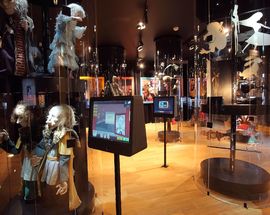
The beloved character Juan Bobo, with his distinctive straw hat and white T-shirt with the Puerto Rican flag, greets visitors at the entrance of the Ballard Institute and Museum of Puppetry, welcoming them to the world’s first puppetry display dedicated to the Caribbean island. The puppets on display in the "Hecho en Puerto Rico" exhibition at the Ballard Institute and Museum of Puppetry range in date from 1960 to the present, and reflect a variety of styles, artistic media, and purposes. Tom Breen / UConn Show More Show Less 4 of9 Kimberly Phillips / UConn Show More Show Less 3 of9 "Little Red Riding Hood" and the "Big Bad Wolf" are rod puppets by Edward Cardenales that were used in school and neighborhood performances in rural Puerto Rico. Kimberly Phillips / UConn Show More Show Less 2 of9 On the right is an oil painting of Pura Belpre, a Puerto Rican puppeteer, librarian and author. If you are a fan of puppets and want to learn about this Czech tradition, you should not miss the shows when visiting Prague.Table-top puppet "Juan Bobo" by Jose Alejandro Lopez is one of the first puppets on display in "Hecho en Puerto Rico: Four Generations of Puerto Rican Puppetry" at the Ballard Institute and Museum of Puppetry. The Říše loutek theatre in Prague has two shows on its repertoire that are suitable for anyone regardless of the language they speak – the puppet operas Don Giovanni and the Magic Flute. You can try the theatre Říše loutek in Prague in the Old Town and the Spejbl and Hurvínek Theatre, or the Ostrava Puppet Theatre.

Even though majority of the puppet shows in theatres are in Czech, it can still be an adventure for your children. You have a few options in the Czech Republic. You will also see the puppets from the Plzeň theatre shows and you can visit the small museum café with a children’s indoor playground and a hall where you and your children can play with the puppets and try the different leading methods. The exposition is interactive, for example, you can play some short performances in the automatic puppet machines. You can learn about both artists and their work in the Puppet Museum in the centre of Plzeň. It is the birthplace of two important puppet creators, Josef Skupa, the father of the Spejbl and Hurvínek puppets, known mostly in Central Europe, and Jiří Trnka, a world-famous illustrator, graphic designer, animator and puppet creator. In the world, Plzeň in West Bohemia is not only famous for its beer and mechanical engineering, but also for puppetry. The circus part includes historical magician and circus instruments, as well as fair attractions from the 19th century, such as a waxworks show with the heads of historical personalities and a moving mermaid.

In addition to the traditional characters of devils, jesters and princesses with dragons, visitors can also see puppets made according to the designs of artists from the 19th century, or Jiří Trnka.
MUSEUM OF PUPPETRY PROFESSIONAL
The part dedicated to puppets maps the history from the oldest puppeteers through family and associated theatres to today’s professional stages. And it is where the Prague National Museum has opened a branch called the Museum of Czech Puppets and Circus.

There are numerous picturesque towns in South Bohemia.

Museum of Czech Puppets and Circus in Prachatice And when you get tired of the exposition, you can stop at the puppet playroom and see for yourselves how a puppet theatre is performed. The international part of the exposition displays shadow puppets from Indonesia, a selection of puppets from India, Japan, China or Myanmar, and also a Vietnamese water puppet. The permanent exposition entitled the Magic World of Puppets introduces puppets of Czech wandering puppeteers from past centuries, vaudeville puppets, family puppet theatres and decorations by leading Czech artists, such as Jiří Trnka. The largest collection of puppets in the Czech Republic can be found in the historical town of Chrudim in East Bohemia where the Museum of Puppet Cultures is based.


 0 kommentar(er)
0 kommentar(er)
